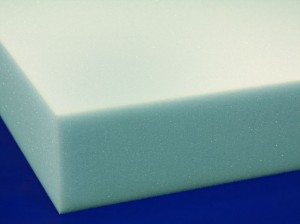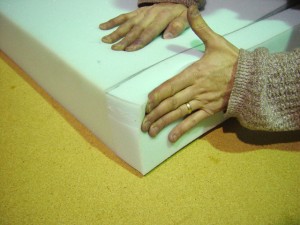Do-it-yourself projects are as popular as they have ever been, as people look for ways to save dollars, enjoy a productive hobby, or take greater ownership of the things in and around their lives. With this trend, people aren’t just doing the typical at-home projects more frequently, they are also expanding their efforts into areas previously reserved for trade workers or manufacturers.

With more than 30 years of experience in the comfort and support industry, Foam Factory, Inc. has seen many trends evolve in home furnishing, and the focus on DIY in recent years is one that has staying power. Things people used to buy without a second thought are now being re-imagined with customization possibilities far beyond anything that can be found in stores.
As people take on a broader set of jobs, custom seating cushions have become a particularly popular project. Whether replacing worn out couch cushions or padding a chair with foam for the perfect feel, making your own cushions from Foam Factory’s line of open-cell foam is surprisingly doable. However, the roadblock that slows many people after they buy foam is when a project can’t be created using a single piece of material. The surprising solution to this problem is as simple as gluing multiple pieces together.
The idea of gluing a material like foam sounds strange, but it has actually been an industry practice for decades. The best news for do-it-yourselfers is that it’s also a very simple process to do at home. With just a couple tips to keep in mind when it comes time to glue, you can put together a beautiful end-product.
When bonding foam together, the kind of adhesive used makes all the difference. With the different chemical formulations used to create foam, some glues won’t be able to form a strong bond, and in a worst case scenario, the wrong adhesive can cause a physical breakdown of the material. Fortunately, special glue for foam is designed specifically for use with the different varieties, and is readily available at craft stores and from many foam providers. Foam Factory stocks adhesives designed for open-cell foam, closed-cell foam, and even special adhesive designed to work with polystyrene, and can help you select an adhesive that lets you use foam varieties without restriction.
Foam adhesives are specially made to function in products used for comfort and support. Sold in the form of aerosol sprays, this assures even distribution across broad surfaces. They are also very strong adhesives, while remaining flexible. This prevents an uncomfortable and hard seam in a cushion, still allowing the foam to flex and compress without tearing. While part of the foundation of DIY is using on-hand materials, spray adhesives are the right tool for the job and perform in ways white glue or brush-on paste can’t.

Once you have the materials you need for a project, there is the matter of knowing the right way to bond the two pieces of foam. When gluing foam, coat both surfaces with adhesive, and allow a few seconds for the glue to get tacky. Once you’re sure your cut foam sections are properly aligned, compress them together with as much pressure as possible. With foam’s absorptive nature, this gets the glue deeper into each piece of foam. Instead of a single, rigid glue line that would be present if the foam was gently compressed, tightly squeezed foam seams have gradual bonds that make cushion pads much stronger and more flexible.
This is easy to do when dealing with smaller cushions, 4 inch foam pads, or throw pillows, but sometimes gluing extra-large pieces of foam together to create cushions for bay window seating gets difficult. When the foam is too large to easily compress together from both sides, there is another method used to ensure you get the strongest bond possible. Using two fingers and your thumb, firmly pinch along the seam, holding for a few seconds before continuing. It’s important to make sure not to tear the foam while doing this, but by getting enough foam between your fingers, you can get a strong bond on even the largest cushions. Don’t forget to gently flip the cushion over either and pinch the bottom edge you didn’t previously have access to. With Foam Factory’s fast-drying adhesive, it only takes minutes after finishing pinching to have cushions ready to be relaxed on.
With these couple tips on DIY cushions, you should be able to create soft seating all through your house, for only the cost of glue and foam!


Related question: Is gluing acoustic foam to closed cell foam viable, will it adhere and support 2″ acoustic foam tiles? My intent is to adhere the closed foam backer to a smooth, poured concrete interior wall, then adhere/glue acoutic foam tiles to the backer foam. My objective is to create a visually pleasing wall in what will become my low-budget vocal recording space. Thanks for yoru reply.
Yes, our 3M Super 77 Spray Adhesiveshould work to glue acoustic foam to closed cell foam.